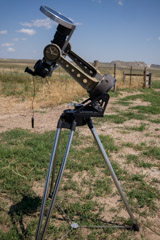The equipment that I used is shown as the assembled system in this photo. I used my Nikon D600 which has a 24 Mpx sensor. The lens was my 300 mm f/4 attached to a Nikon TC-301, 2x tele-extender, giving me a 600 mm f/8 lens. This system was attached to an adapter that I fabricated in aluminum and which I attached to the fork drive of my Celectron C8 telescope (having first removed the telescope, of course). The fork drive was bolted to the Celestron's polar wedge which was, in turn, mounted on the Celestron's sturdy tripod. My solar filter is an 8 inch filter that I use with the Celestron. This filter has a very large diameter compared to the lens and is only attached to the adapter via the filter's metal frame which rests on the aluminum channel of the adapter in two short lines at just one azimuth. Because of its quick-and-easy but not-so-rigid attachment, it acted as a sail in the intermittent wind, and this susceptibility caused the entire apparatus to vibrate unacceptably for perfectly sharp photographs. Such vibrations damped out in a few seconds, so I could accept them as being merely inconvenient.
I used a remote shutter release to avoid producing vibrations when touching the camera to make exposures. I also used the mirror-up facility of the D600 which enables me to raise the SLR mirror with a first command from the shutter release and then wait for the associated vibrations to damp out before making an exposure with a second command. The wind complicated my care in this regard. It blew prior to totality but (strangely?) died during totality and then picked back up afterwards. For the later photos, I found by trial that I could and usually did need to steady the system for most photographs in the renewed winds by using one hand to make the solar filter a more rigid part of the entire system. I conclude that I should have spent the cash to buy a solar filter of the proper size to screw onto the lens. That would have dramatically reduced the problem with wind-caused vibration and probably would have increased the sharpness of the photographs.
I did not have sufficient time to properly level the top of the tripod to which the fork attaches nor to align the polar axis of the fork drive. Consequently all of the photographs have been made with the north at an angle of about 15° counter-clockwise from the vertical side of the photographic frame. It is possible to be somewhat precise in this, because the bright star Regulus in the constellation Leo can be seen in most of the photos of the solar corona, and because the Moon's motion following the eclipse put it in a very close conjunction 0.5° S of Regulus at 14:25, about 2 hours 20 minutes following the end of the eclipse at my observation site. So by extrapolating the Moon's motion from its course across the sun to its probable position south of Regulus and by knowing that the Moon's motion is effectively along the eclliptic, and by knowing that the ecliptic in Regulus runs at about 21° south of the celestial equator, I can estimate the angle of the north direction in the photographs.

